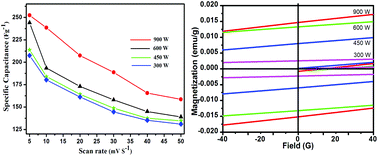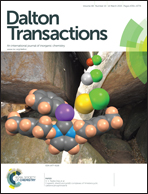Influence of microwave power on the preparation of NiO nanoflakes for enhanced magnetic and supercapacitor applications†
Abstract
Nanoflake-structured NiO were synthesized by a microwave assisted method without the use of additives. The cubic phase of NiO nanoparticles with increasing crystalline nature for higher microwave power is ascertained by X-ray diffraction studies. Previous reports revealed that hexagonally structured β-Ni(OH)2 was completely transferred into the cubic phase of NiO around 350 °C, confirmed by using thermal analysis (TG/DTA). In our present work, the size and morphology of nanoparticles are ascertained from transmission electron microscopy (TEM) analysis. Flake-like morphology with uniform size, shape and less agglomerated structure formation is obtained for 900 and 600 W of microwave power used for the synthesis of NiO samples. The effect of microwave power used for the synthesis of NiO nanoflakes was analyzed by studying the magnetic and electrochemical behavior of NiO nanoflakes. Room temperature magnetic measurements revealed the small ferromagnetic nature of NiO nanoparticles. It was observed that the samples synthesized at higher microwave power exhibited divergence behavior below 300 K in FC and ZFC measurements, which results superparamagnetic behavior. An enhanced supercapacitor performance with higher specific capacitance values was determined for NiO nanoflake samples synthesized at 25600 W and 900 W of microwave power.


 Please wait while we load your content...
Please wait while we load your content...